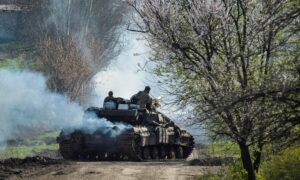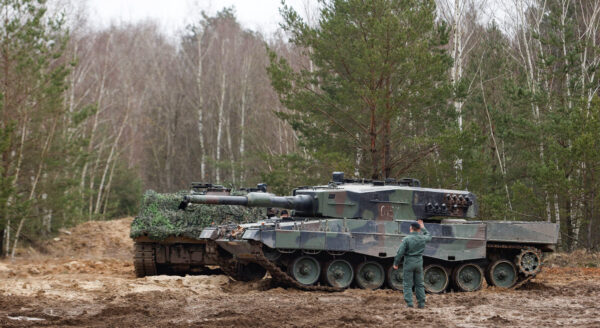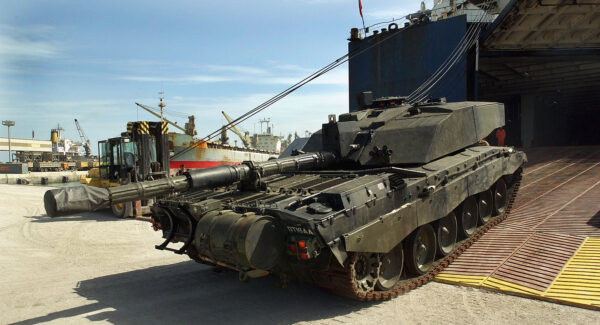US–NATO Tanks—Will They Make a Significant Difference?
Commentary Western tanks will “burn like all the rest,” Kremlin spokesperson Dmitry Peskov said. The statement by Pesckov must be viewed in the context of the dozens and dozens of articles speaking glowingly about how great Leopard and Abrams tanks are, how easily they will dispatch Russian tanks, and how they will ensure victory for Ukraine over Russia. Russia disagrees Still, while Russia isn’t quaking in fear of the U.S./NATO tanks that will be entering battle, neither is it ignoring them. Indeed, in response to the United States’ and its NATO allies’ donation of tanks to Ukraine, Russia is reportedly forming tank-killer groups (TKGs) whose focus will be on destroying and/or capturing any modern armor provided to Kyiv by the United States and its NATO allies. To this end, on April 9, Russian Armed Forces Combat Training Center head Yevgeny Arifulin revealed Russia’s study of the weaknesses and strengths of NATO tanks that has been used by Col. Gen. Ivan Buvaltsev to create “methodological recommendations” that will be used to train the TKGs in how to destroy Western tanks. Along with official government action, such as the creation of TKGs, some Russian businesses and officials have offered cash bounties for the destruction of Western military equipment in Ukraine. Aleksandr Osipov, the governor of Russia’s Zabaikalsky Region, signed an order in January promising local soldiers 3 million rubles ($37,000) for capturing an operational Leopard 2 tank, or 1 million rubles ($12,000) for destroying one. While Russia specifically targeting Western tanks is noteworthy, the bigger question is, will they actually make a difference in the outcome of the war? To answer that question, we must first know exactly how many tanks Ukraine may be receiving, when it will be receiving them, and just what kind of capabilities the delivered tanks bring to the table. A Polish soldier navigates a Leopard 2 tank during a training at a military base and test range in Swietoszow, Poland, on Feb. 13, 2023. (Michal Dyjuk/AP Photo) The number of Western-style tanks, their type, and when they will be delivered to Ukraine is a moving target, but as of mid-April it looks like that number is around 300—including at least 67 Leopard 2s (and variants), 31 M1A1 Abrams, 14 Challenger 2s, and 178 Leopard 1 tanks. And France promised 10 AMX-10RC wheel tanks. As of mid-April, Ukraine has reportedly received at least 71 of the pledged tanks, including 47 Leopard 2s, the 10 AMX-10RCs, and 14 Challenger 2s. The delivery of the rest of the tanks is contingent on how quickly they can be pulled out of mothballs, refurbished, and made ready for battle. There are no exact delivery dates; instead, delivery times are being couched in terms of seasons and years. With that said, the United States is promising to get the 31 M1A1 Abrams to Ukraine by the fall of this year. Germany, Denmark, and the Netherlands are going to deliver some 20 Leopard 1 tanks in summer 2023, another 80 by year-end, and the remaining 78 sometime in 2024. Consequently, only a small portion of the promised tanks will be able to take part in any kind of spring counteroffensive. And even if a counteroffensive was delayed to summer, it’s likely that less than half of the pledged tanks will be delivered by that time. Then you have the question of their unique and substantial support requirements. This begs the question of just how big an impact the Western tanks can potentially make on the outcome of the war. Evaluating their potential impact requires knowing some detail about the tanks Ukraine is going to receive. And by far and away, Leopard 1s compose the bulk of the pledged tanks. For starters, having been designed in the late 1950s, the Leopard 1 tanks being pulled out of storage and refurbished are by no stretch of the imagination modern battle tanks. While its 105 millimeter (mm) rifled gun was great for its day, it’s outmatched by current 125 mm and 120 mm tank guns used by Russian and NATO tanks, and its armor is wholly inadequate to being a frontline main battle tank. With that said, used properly, they can play an important supporting role, and their gun is perfectly capable of destroying armored vehicles and could be a threat to other better-armored tanks if they can maneuver to deliver shots to their rear or side armor. But given that it’s demonstrably inferior to many tanks Ukraine already has in its inventory, it really is just another tank that will have less impact than the heavily modernized T-72s the Czech Republic, Poland, and Morocco have pledged to Ukraine. The next largest tranche of Western tanks Ukraine will be receiving are Leopard 2s, both Leopard 2A4s and Leopard 2A6s. However, as often is the case, the devil is in the details, as not all Leopard 2s were created equal. In particular, there’s a significant difference in firepower and survivability between the Leopard 2A4s and the Leopard 2A6s Ukraine is receiving. The A4s feature the L44 Rheinmet

Commentary
Western tanks will “burn like all the rest,” Kremlin spokesperson Dmitry Peskov said.
The statement by Pesckov must be viewed in the context of the dozens and dozens of articles speaking glowingly about how great Leopard and Abrams tanks are, how easily they will dispatch Russian tanks, and how they will ensure victory for Ukraine over Russia. Russia disagrees
Still, while Russia isn’t quaking in fear of the U.S./NATO tanks that will be entering battle, neither is it ignoring them. Indeed, in response to the United States’ and its NATO allies’ donation of tanks to Ukraine, Russia is reportedly forming tank-killer groups (TKGs) whose focus will be on destroying and/or capturing any modern armor provided to Kyiv by the United States and its NATO allies. To this end, on April 9, Russian Armed Forces Combat Training Center head Yevgeny Arifulin revealed Russia’s study of the weaknesses and strengths of NATO tanks that has been used by Col. Gen. Ivan Buvaltsev to create “methodological recommendations” that will be used to train the TKGs in how to destroy Western tanks.
Along with official government action, such as the creation of TKGs, some Russian businesses and officials have offered cash bounties for the destruction of Western military equipment in Ukraine. Aleksandr Osipov, the governor of Russia’s Zabaikalsky Region, signed an order in January promising local soldiers 3 million rubles ($37,000) for capturing an operational Leopard 2 tank, or 1 million rubles ($12,000) for destroying one.
While Russia specifically targeting Western tanks is noteworthy, the bigger question is, will they actually make a difference in the outcome of the war? To answer that question, we must first know exactly how many tanks Ukraine may be receiving, when it will be receiving them, and just what kind of capabilities the delivered tanks bring to the table.

The number of Western-style tanks, their type, and when they will be delivered to Ukraine is a moving target, but as of mid-April it looks like that number is around 300—including at least 67 Leopard 2s (and variants), 31 M1A1 Abrams, 14 Challenger 2s, and 178 Leopard 1 tanks. And France promised 10 AMX-10RC wheel tanks.
As of mid-April, Ukraine has reportedly received at least 71 of the pledged tanks, including 47 Leopard 2s, the 10 AMX-10RCs, and 14 Challenger 2s. The delivery of the rest of the tanks is contingent on how quickly they can be pulled out of mothballs, refurbished, and made ready for battle. There are no exact delivery dates; instead, delivery times are being couched in terms of seasons and years. With that said, the United States is promising to get the 31 M1A1 Abrams to Ukraine by the fall of this year. Germany, Denmark, and the Netherlands are going to deliver some 20 Leopard 1 tanks in summer 2023, another 80 by year-end, and the remaining 78 sometime in 2024.
Consequently, only a small portion of the promised tanks will be able to take part in any kind of spring counteroffensive. And even if a counteroffensive was delayed to summer, it’s likely that less than half of the pledged tanks will be delivered by that time. Then you have the question of their unique and substantial support requirements. This begs the question of just how big an impact the Western tanks can potentially make on the outcome of the war.
Evaluating their potential impact requires knowing some detail about the tanks Ukraine is going to receive. And by far and away, Leopard 1s compose the bulk of the pledged tanks.
For starters, having been designed in the late 1950s, the Leopard 1 tanks being pulled out of storage and refurbished are by no stretch of the imagination modern battle tanks. While its 105 millimeter (mm) rifled gun was great for its day, it’s outmatched by current 125 mm and 120 mm tank guns used by Russian and NATO tanks, and its armor is wholly inadequate to being a frontline main battle tank.
With that said, used properly, they can play an important supporting role, and their gun is perfectly capable of destroying armored vehicles and could be a threat to other better-armored tanks if they can maneuver to deliver shots to their rear or side armor. But given that it’s demonstrably inferior to many tanks Ukraine already has in its inventory, it really is just another tank that will have less impact than the heavily modernized T-72s the Czech Republic, Poland, and Morocco have pledged to Ukraine.
The next largest tranche of Western tanks Ukraine will be receiving are Leopard 2s, both Leopard 2A4s and Leopard 2A6s. However, as often is the case, the devil is in the details, as not all Leopard 2s were created equal. In particular, there’s a significant difference in firepower and survivability between the Leopard 2A4s and the Leopard 2A6s Ukraine is receiving.
The A4s feature the L44 Rheinmetall 120 mm smoothbore gun. This is a very good gun and is essentially the same gun used by the U.S. M1 Abrams. However, the A6 version of the Leopard 2 was upgraded with the significantly more powerful L55 gun due to concerns that unless the L44 is using depleted uranium-based projectiles, it will have trouble penetrating the armor of Russia’s newer main battle tanks.
The other difference is that the A6 shape was changed and its armor upgraded due the A4’s weakness against any number of modern anti-tank weapons, including Russia’s 125 mm guns. This doesn’t mean that skillfully commanded Leopard 2A4s will not be highly effective; it just means they may not be quite as good as portrayed.
On the other hand, the more modern Leopard 2A6s are excellent tanks that will be superior to the vast majority of the Russian tanks they will be facing.
Regarding the 10 Swedish Strassman 122 tanks promised to Ukraine by Sweden, but have not yet been delivered, these are Leopard 2A5 variants with the same gun as the A4, but with the armor of A6s. So, they’re also very good tanks.

The 14 Challenger 2s that have reportedly been delivered to Ukraine are excellent tanks with good overall armor protection and a powerful rifled 120 mm gun capable of firing both kinetic energy penetrator rounds and high explosive squash head (HESH) rounds. As is the case with the Leopard 2A6, their combination of firepower and armor protection makes them superior to the overwhelming majority of Russian tanks.
The M1A1s that will be delivered later this year will not be available for a spring or summer counteroffensive but are also very good tanks, with their main weakness being that they are gas guzzlers that require a whole bunch of maintenance and support. If used properly, they too will be superior to the vast majority of Russian tanks they will face.
At this juncture it must be pointed out that even the best tanks have vulnerabilities and that Russia fields a wide variety of weapons that have the potential to destroy or cripple any tank. Of course, the wide variety of weapons Russia fields includes its tanks, which can fire lethal 125 mm rounds, as well as main gun launched guided anti-tank missiles, both of which are situationally capable of destroying any of the Western tanks being sent to Ukraine.
Given the preceding analysis, it’s clear that while some of the tanks being donated to Ukraine are excellent, the numbers being donated are relatively small as compared to counteroffensives involving many thousands of troops, hundreds of tanks, hundreds of armored vehicles, artillery, air power, etc.
Further, any tanks involved in offensive operations will be operating in one of the most tank-unfriendly environments ever seen, as they will not be able to count on air support, and will not only be going up against tanks, but will also be facing massed artillery fires, hundreds, perhaps even thousands of troops with lethal man-portable anti-tank weapons, and in some cases Russian airpower. Further, there’s little doubt that with all the hype surrounding the U.S./NATO tanks, they will be blessed with all sorts of extra attention from specially trained anti-tank squads whose focus is on killing them.
Views expressed in this article are the opinions of the author and do not necessarily reflect the views of The Epoch Times.












